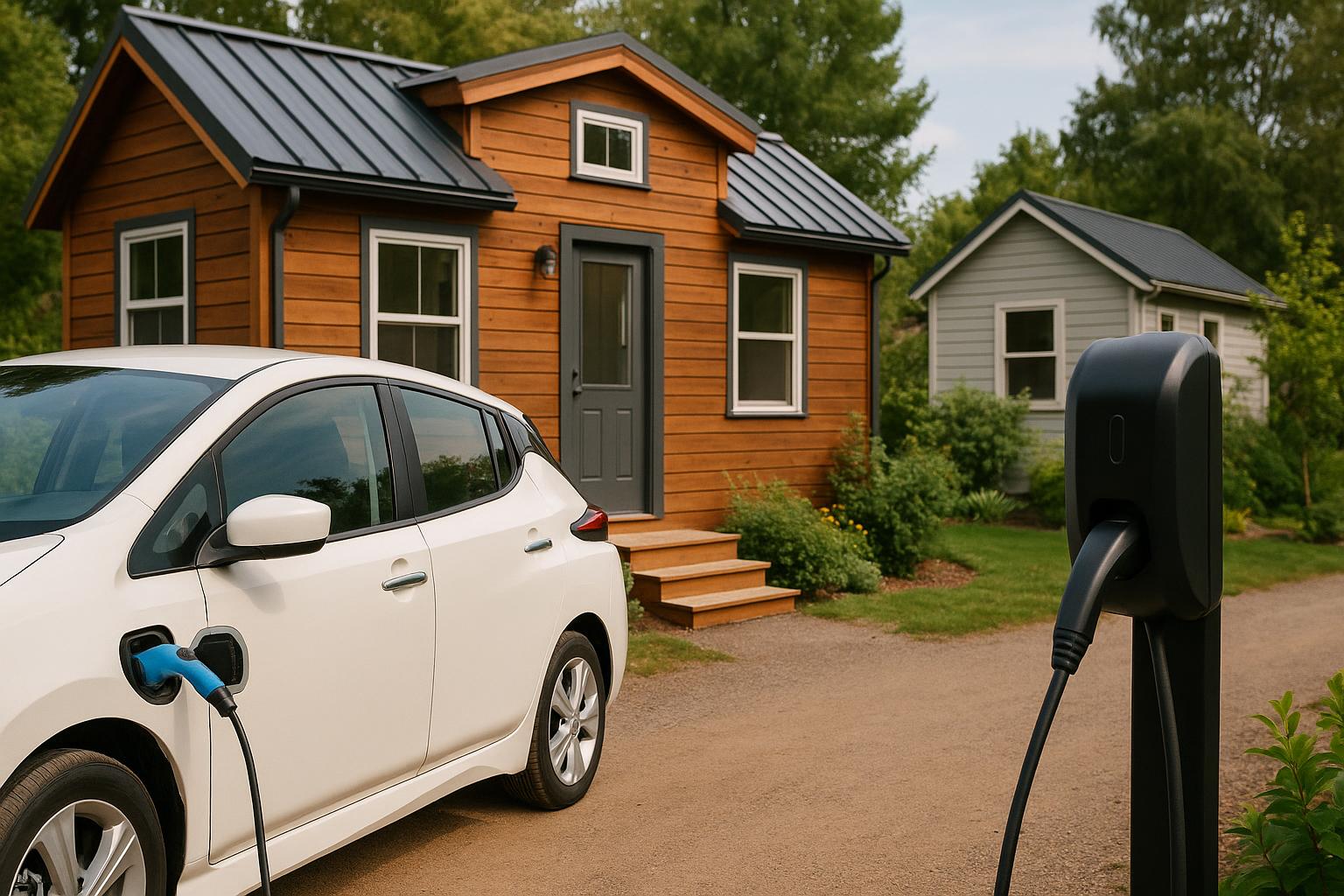
Estimated reading time: 7 minutes
Key Takeaways
- EV charging is emerging as an essential upgrade for eco-conscious tiny homes and ADUs in Canada.
- Modern tiny home tech integrates compact, efficient charging solutions tailored to small spaces.
- Smart home integration simplifies energy management and helps lower utility costs.
- Adopting sustainable transport reduces carbon footprints and supports a low-carbon future.
Table of contents
EV Charging: The Must-Have Feature for Canada’s Eco-Conscious Tiny Homes and ADUs
Introduction: EV Charging and Sustainable Transport in Small Canadian Homes
EV charging has quickly become an essential upgrade for eco-conscious Canadian homeowners—and it’s easy to see why. As sustainable transport booms across Canada, the push for electric vehicles (EVs) is accelerating at a record pace. In fact, current estimates predict that zero-emission vehicles will soar from approximately 480,000 to an incredible 5 million by 2030. This dramatic rise is matched by a growing demand for at-home EV charging solutions, especially for those prioritizing green lifestyles (source; source).
But what does this mean for Canadians living in tiny homes and Canadian ADUs? For these residents, maximizing space and energy efficiency is a daily goal—and integrating EV charging can seem impossible. Fortunately, the landscape is changing. Modern tiny home tech now includes flexible, compact, and innovative charging systems tailored for small spaces.
Smart home technology is key in this transition. Not only does it simplify EV charging, but it helps homeowners manage energy more efficiently, reduce bills, and optimize convenience. In this guide, we’ll break down everything Canadian homeowners in small dwellings need to know to make EV charging a seamless part of their sustainable lifestyle. For more information, check out Tiny Home Living: Your Complete Guide to Micro Homes, Sustainability, and Lifestyle Freedom.
Understanding EV Charging Basics for Tiny Home Tech
Before planning your own home EV charging setup, it’s vital to understand the available options and key installation requirements, particularly in the context of tiny home tech.
EV Charging Options for Small Spaces
- Level 1 Charging
- Utilizes a standard 120V household outlet.
- Provides about 8 km of range per hour.
- Ideal for overnight charging and lower daily driving needs in tiny homes or ADUs with limited electrical service.
- Level 2 Charging
- Requires a 240V circuit (similar to electric stoves or dryers).
- Delivers over 30 km of range per hour.
- Compact, wall-mountable chargers work best for small spaces.
- Dedicated Home Charging Stations
- Feature programmable charging schedules.
- Integrate with home energy management systems.
- Designed for minimal space impact and easy installation.
Installation and Power Considerations
- Electrical Capacity: Check if your tiny home or ADU’s smaller electrical panel requires an upgrade.
- Safe Mounting: Outdoor-rated chargers might be necessary for exterior installations.
- Building/Electrical Codes: Compliance with local codes is mandatory for placement, wiring, and safety features.
Always evaluate your current electrical setup and work with professionals for a safe, code-compliant installation. Learn more about integrating smart energy management with your setup at Smart Home Technology for ADUs: A Complete Guide to Maximizing Comfort, Security, and Efficiency in Canadian Tiny Homes.
Tiny Home Tech and Canadian ADUs: Space-Saving Features for Sustainable Homes
What is Tiny Home Tech?
Tiny home tech involves using high-efficiency, compact, and modular technologies to support minimalist, energy-friendly living. It encompasses not just small appliances but also specialized HVAC systems, water management, and integrated EV charging solutions.
Explore how these innovations are transforming lifestyles in our guide Tiny Home Living: The Ultimate Guide to Affordable, Sustainable, and Stylish Compact Living.
The Rise of Canadian ADUs
Canadian ADUs—such as backyard suites, laneway houses, or garden cottages—offer flexible, eco-friendly living and rental opportunities while increasing housing density. They are ideal candidates for integrated sustainable features like EV charging.
For an in-depth look, read Accessory Dwelling Units: The Ultimate Guide to ADUs for Canadian Property Investment.
Small-Space Limitations That Affect EV Charging
- Limited Square Footage: With no dedicated garage or driveway, chargers must be compact or installed outdoors.
- Reduced Electrical Panel Size: Older ADUs or ultra-compact builds may have basic services (40-100A), limiting high-powered charging.
- Weather Exposure: Chargers must handle harsh Canadian winters, making weatherproofing essential.
Modern EV charging solutions overcome these limitations, making eco-friendly, year-round living in even the smallest homes possible. Read more about preparing your tiny home for winter in How to Build a Winter-Proof Tiny Home Designed for the Harsh Canadian Climate.
Integrating EV Charging with Tiny Home Tech: Innovative Solutions
Flexible Charging Solutions
- Portable EV Chargers
- Plug-and-go units that can be stored when not in use.
- Perfect for multi-vehicle or off-site charging needs.
- Compact Wall-Mount/Foldaway Stations
- Designed to occupy minimal space; suitable for indoor or outdoor mounting.
- Some models fold flat to maximize available room.
- Solar-Powered Charging
- Utilizes rooftop solar arrays or solar canopies for renewable energy.
- Allows for off-grid or hybrid charging, enhancing energy independence.
Combining tiny home tech with sustainable transport enables homeowners to match charger capabilities to daily travel needs. Learn about integrating solar energy with your charger in The Ultimate Guide to Solar-Powered ADUs for Canadian Homes: Design, Financing, Installation, and Benefits Explained.
Smart Home Integration: Optimizing Charging and Home Power Use
- Balance EV charging with other home loads to avoid overload.
- Schedule charging during solar peaks or off-peak rates to reduce costs.
- Monitor charging status, energy consumption, and battery health remotely via your smartphone.
In BC’s Gulf Islands, tiny homeowners run portable Level 2 chargers powered by wall-mounted solar panels and managed through smart home apps. Their automated scheduling ensures optimal battery charging during peak solar output, resulting in near-zero utility bills during shoulder seasons.
For more on smart home integration in compact spaces, check out Tiny Smart Home: How to Optimize Comfort, Space, and Innovation in Compact Canadian Living.
EV Charging in Canadian ADUs: Overcoming Challenges with Smart Design
Key Challenges
- Regulatory Requirements: Some provinces, like Ontario and Manitoba, are enforcing EV-ready mandates in ADU building codes.
- Permitting and Utility Upgrades: Installing new circuits or upgrading panels may require municipal or utility approval.
- Limited Power Capacity: Many ADUs are designed for basic power loads and may not support high-demand chargers without modifications.
Understand the regulatory landscape in Canadian ADU Regulations: A Comprehensive Provincial Guide to Secondary Suites, Zoning Laws, and Building Permits.
Smart Solutions for Canadian ADUs
- Smart Electrical Panels & Energy Storage
- Upgrading to a smart panel enables real-time monitoring and dynamic load balancing.
- Integrated battery storage helps shift energy usage to off-peak times when powering EVs.
- Intelligent Load Sharing
- Modern chargers can automatically limit power draw if other appliances are running.
- Smart Home Platforms
- Systems like Home Assistant or Apple HomeKit let you control and schedule energy loads from a single interface.
These innovations ensure that even compact, code-compliant ADUs can benefit from efficient EV charging. For additional details, visit Smart Home Technology for ADUs: Maximizing Tiny Home Living in Canada.
Smart Home Technology: Transforming the EV Charging Experience
Advantages of Smart Home-Integrated Charging
- Automated Charging Schedules: Set charging to begin during off-peak hours or renewable energy surpluses.
- Remote Monitoring and Alerts: Use smartphone apps to track energy usage and manage charging remotely.
- Seamless Renewable Integration: Sync chargers with solar arrays and battery systems to prioritize green energy.
- User-Friendly Controls: Adjust settings and monitor power usage through an intuitive dashboard.
Linking EV charging to home automation not only prevents peak utility charges but also ensures safe power distribution. Discover more in The Ultimate Guide to Energy Efficiency Tiny Homes: Smart Strategies for Sustainable Canadian Living.
The Benefits of Sustainable Transport and Small-Space Living
Environmental Impact
- Reduced Carbon Footprint: Zero-emission vehicles and renewable-powered charging dramatically lower transportation emissions.
- Increased Efficiency: Smart energy management ensures power is used when it’s cleanest and most cost-effective.
- Enhanced Use of Renewables: Charging directly with solar energy is a clear win for the environment.
Enhanced Lifestyle and Future Readiness
- Greater Mobility: Home charging eliminates dependence on public stations.
- Future-Proof Homes: Smart systems keep your home updated with the latest energy technologies.
Financial Incentives
- Rebates and Grants: Federal and provincial programs can cover up to 50% of installation costs.
- Long-Term Savings: Lower utility bills and efficient energy use translate into ongoing cost benefits.
For further insights on sustainable housing, see Tiny Sustainable Living: How Eco-Friendly Homes and Energy-Efficient Design Are Shaping the Future of Sustainable Housing.
Practical Tips and Considerations for Homeowners: EV Charging Success in Small Spaces
Planning Checklist
- Evaluate Electrical Capacity: Check your main panel and service size; consider upgrades for Level 2 charging.
- Select the Right Charger: Level 1 chargers for basic needs; Level 2 for faster, more efficient recharging.
- Opt for Space-Saving, Weatherproof Designs: Choose compact chargers suitable for limited indoor or outdoor spaces.
- Integrate Smart Home Systems: Utilize compatible systems for remote monitoring and energy management.
- Consult a Certified Electrician: Always work with a licensed professional familiar with Canadian codes.
- Apply for Incentives: Research available rebates for chargers, service upgrades, and renewable installations.
Maintenance and Safety
- Schedule regular safety checks for outlets, cords, and equipment.
- Ensure proper ventilation and weatherproofing for all outdoor installations.
- Keep firmware updated on smart chargers for optimal performance.
EV charging in small spaces is not only feasible but an investment in a sustainable lifestyle. For seasonal maintenance tips, see ADU Maintenance Checklist: Essential Seasonal Care Tips for Canadian Homeowners.
Conclusion: Future-Proofing Canadian Small Homes with EV Charging and Smart Home Tech
Integrating EV charging is now essential for making tiny homes and Canadian ADUs sustainable, efficient, and future-ready. Advances in tiny home tech and smart home systems allow even the smallest dwellings to support fast, reliable, and eco-friendly vehicle charging.
Smart design and automation overcome the challenges of small-space living, delivering ongoing savings and convenience. By embracing innovative energy management and renewable integration, these homes actively contribute to a cleaner, low-carbon future.
Now is the time for eco-conscious Canadian homeowners to explore available rebates, consult experts, and invest in state-of-the-art EV charging solutions—making Canada greener, one small home at a time.
Frequently Asked Questions
-
Q: Can EV charging systems be installed in extremely compact spaces?
A: Yes, thanks to advances in tiny home tech, there are many compact, wall-mountable options designed specifically for small spaces.
-
Q: Do I need to upgrade my electrical panel for Level 2 charging?
A: Often, tiny homes and ADUs may require an upgrade to safely support Level 2 charging. It’s best to consult with a certified electrician.
-
Q: How does smart home technology improve the EV charging experience?
A: Smart systems allow automated scheduling, remote monitoring, and integration with renewable energy sources, optimizing efficiency and reducing costs.
-
Q: Are there government incentives available for installing EV charging systems?
A: Yes, various federal and provincial programs offer rebates and grants that can cover up to 50% of installation and equipment costs.

Leave a Reply